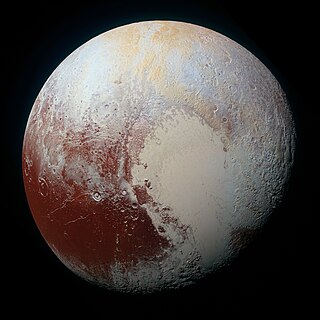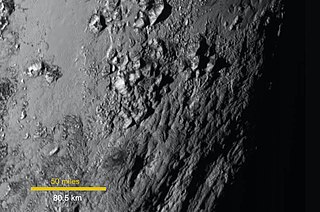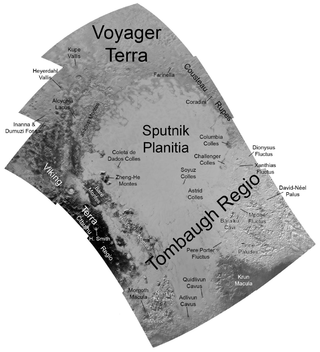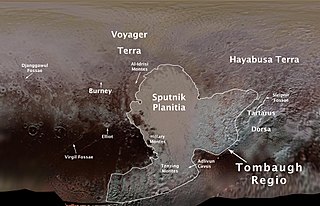Related Research Articles

Clyde William Tombaugh was an American astronomer. He discovered Pluto in 1930, the first object to be discovered in what would later be identified as the Kuiper belt. At the time of discovery, Pluto was considered a planet, but was reclassified as a dwarf planet in 2006. Tombaugh also discovered many asteroids, and called for the serious scientific research of unidentified flying objects.

Planetary nomenclature, like terrestrial nomenclature, is a system of uniquely identifying features on the surface of a planet or natural satellite so that the features can be easily located, described, and discussed. Since the invention of the telescope, astronomers have given names to the surface features they have discerned, especially on the Moon and Mars. To found an authority on planetary nomenclature, the International Astronomical Union (IAU) was organized in 1919 to designate and standardize names for features on Solar System bodies.

New Horizons is an interplanetary space probe launched as a part of NASA's New Frontiers program. Engineered by the Johns Hopkins University Applied Physics Laboratory (APL) and the Southwest Research Institute (SwRI), with a team led by Alan Stern, the spacecraft was launched in 2006 with the primary mission to perform a flyby study of the Pluto system in 2015, and a secondary mission to fly by and study one or more other Kuiper belt objects (KBOs) in the decade to follow, which became a mission to 486958 Arrokoth. It is the fifth space probe to achieve the escape velocity needed to leave the Solar System.

Venetia Katharine Douglas Burney was an English accountant and teacher. She is remembered as the first person to suggest the name Pluto for the dwarf planet discovered by Clyde Tombaugh in 1930. At the time, she was 11 years old.
Krun or Akrun is a Mandaean lord of the underworld. According to Mandaean cosmology, he dwells in the lowest depths of creation, supporting the entirety of the physical world.

The exploration of Pluto began with the arrival of the New Horizons probe in July 2015, though proposals for such a mission had been studied for many decades. There are no plans as yet for a follow-up mission, though follow-up concepts have been studied.

Tombaugh Regio, sometimes called "Pluto's heart" after its shape, is the largest bright surface feature of the dwarf planet Pluto. It is just north of the equator, to the northeast of Cthulhu Macula and to the northwest of Krun Macula, which are both dark features. Its western lobe, a 1,000 km (620 mi)-wide plain of nitrogen and other ices lying within a basin, is named Sputnik Planitia. The eastern lobe consists of high-albedo uplands thought to be coated by nitrogen transported through the atmosphere from Sputnik Planitia, and then deposited as ice. Some of this nitrogen ice then returns to Sputnik Planitia via glacial flow. The region is named after Clyde Tombaugh, the discoverer of Pluto.

Belton Regio is a prominent surface feature of the dwarf planet Pluto. It is an elongated dark region along Pluto's equator, 2,990 km (1,860 mi) long and one of the darkest features on its surface.

The geography of Pluto is mainly focused the distribution of physical features across Pluto. On 14 July 2015, the New Horizons spacecraft became the first spacecraft to fly by Pluto. During its brief flyby, New Horizons made detailed geographical measurements and observations of Pluto and its moons.

The Tenzing Montes are a range of icy mountains on Pluto, bordering the southwest region of Sputnik Planitia and the nearby Hillary Montes and Wright Mons. With peaks reaching 6.2 km in height, they are the highest mountain range on Pluto, and also the steepest, with a mean slope of 19.2 degrees.

Sputnik Planitia is a large basin on Pluto, about 1,050 by 800 km in size, partially submerged in large, bright glaciers of nitrogen ice. Named after Earth's first artificial satellite, Sputnik 1, it constitutes the western lobe of the heart-shaped Tombaugh Regio. Sputnik Planitia lies mostly in the northern hemisphere, but extends across the equator. Much of it has a surface of irregular polygons separated by troughs, interpreted as convection cells in the relatively soft nitrogen ice. The polygons average about 33 km (21 mi) across. In some cases troughs are populated by blocky mountains or hills, or contain darker material. There appear to be windstreaks on the surface with evidence of sublimation. The dark streaks are a few kilometers long and all aligned in the same direction. The planitia also contains pits apparently formed by sublimation. No craters were detectable by New Horizons, implying a surface less than 10 million years old. Modeling sublimation pit formation yields a surface age estimate of 180000+90000
−40000 years. Near the northwest margin is a field of transverse dunes, spaced about 0.4 to 1 km apart, that are thought to be composed of 200-300 μm diameter particles of methane ice derived from the nearby Al-Idrisi Montes.

The Hillary Montes or are a mountain range that reach 3.5 km above the surface of the dwarf planet Pluto. They are located northwest of Tenzing Montes in the southwest border area of Sputnik Planitia in the south of Tombaugh Regio. The Hillary Montes were first viewed by the New Horizons spacecraft on 14 July 2015, and announced by NASA on 24 July 2015.

Hayabusa Terra is a surface feature on the dwarf planet Pluto. It was discovered by the New Horizons spacecraft in July 2015. It is named for Hayabusa, the first spacecraft to successfully return a sample of an asteroid to Earth. The name has been officially approved by the International Astronomical Union on 7 September 2017.

Lowell Regio is a region on the dwarf planet Pluto. It was discovered by the New Horizons spacecraft in 2015. The region corresponds to the Plutonian northern polar cap. It is named after Percival Lowell who established the observatory where Clyde Tombaugh discovered Pluto.
Pioneer Terra is a region on the dwarf planet Pluto, north of Tombaugh Regio and east of Voyager Terra. It was discovered by the New Horizons spacecraft on 14 July 2015. It is named for the Pioneer program, which included Pioneer 10 and Pioneer 11, the first spacecraft to cross the asteroid belt and explore Jupiter and Saturn, as well as the first to explore the outer Solar System; Pioneer 6, 7, 8, and 9, which formed an "interplanetary weather network"; Pioneer 1 through 5, which explored the Moon in various ways; and the Pioneer Venus project, consisting of a probe and orbiter to Venus.

The Venetia Burney Student Dust Counter (VBSDC) is a scientific instrument aboard the uncrewed New Horizons space probe that is designed to detect dust impacts in outer space. VBSDC is the first planetary science instrument to be built by students. The dust counter was launched in 2006, and named later that year after Venetia Burney, the young girl who originally named Pluto. The detector works when dust strikes films of polarized polyvinylidene fluoride (PVDF), which generates an electrical charge. The space dust is then detected over the course of the New Horizons spacecraft flight out of the Solar System and past Pluto.
The Baret Mountains is a chain of mountains on the surface of the dwarf planet Pluto. It is located near the west border of Sputnik Planitia in the Tombaugh Regio. These mountains were first viewed by the New Horizons spacecraft. It features large ridges that are formed by the compression of methane and water ice.
References
- ↑ "Pluto Features Given First Official Names". NASA. 7 September 2017.

